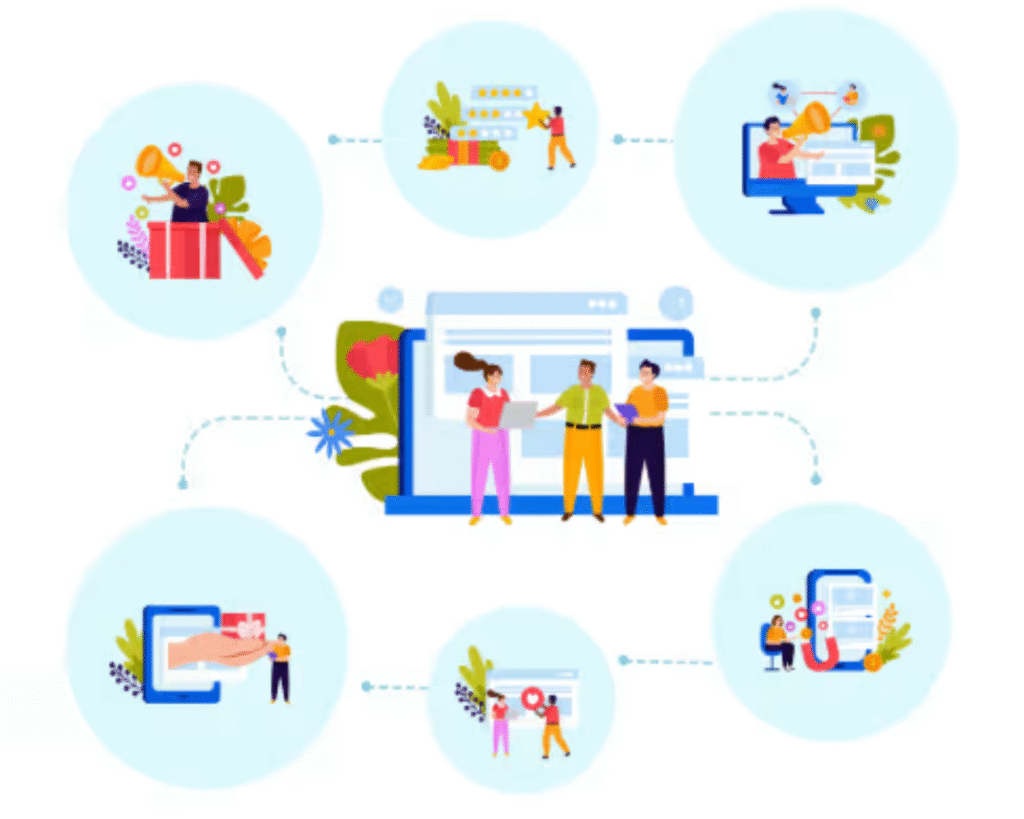A company can receive messages from customers on several different channels, and meeting all this demand can take time. Without a platform capable of centralizing and organizing all these interactions, the process becomes confusing and slow.
Regardless of the size of your business, investing in an omnichannel platform allows you to receive messages from different channels on a single dashboard, continuing conversations and responding quickly and consistently.
With that in mind, we have prepared this article to show you what an omnichannel platform is and how these tools integrate each stage of the consumer experience, bringing greater operational efficiency and more satisfying experiences for the public.
What is an omnichannel platform?
An omnichannel platform is a tool used to integrate and manage interactions across all of a company’s communication channels. It provides a unified experience, where customers receive continuous and consistent service, regardless of the channel used.
With this type of system, the channels begin to act in a complementary manner, ensuring that support is consistent and that each person is served according to their needs and preferences.
Another advantage is that the history of interactions and customer data remains centralized, avoiding repetition and conveying professionalism, organization, and trust. In addition, updating this information becomes simple and agile, allowing sales and customer service teams to work in an integrated and aligned manner.

How to use an omnichannel platform in your customer service?
Now that you know how an omnichannel platform can transform the customer experience and boost business performance, it’s time to put your strategy into practice. But where do you start?
1. Find out where the customer is located
The starting point is to identify which channels, devices, and platforms are part of your customers’ routine.
More than just knowing where they are, it is important to understand how they behave in these spaces, the tone of communication they use, and what the main challenges they face are.
At this point, rely on concrete information, not assumptions. This data will be the backbone of your omnichannel strategy and will help reduce risks that could damage your brand image and relationship with the public.
2. Organize the work of the customer service team
Even with automation helping to streamline processes, the role of the customer service team remains crucial to generating good results.
An essential decision is to define how agents will handle the different channels: will each agent be responsible for a specific channel, or will they all work in an integrated manner?
Analyze the advantages and disadvantages of each format and choose the one that best suits your operating model.
3. Create specific strategies for each channel
Each communication channel has its own characteristics and requires a compatible service style.
Before configuring the omnichannel platform, assess the volume of interactions, peak times, audience behavior profile, and level of demand on each channel. This observation will guide the customization of the approach and increase the effectiveness of the service.
4. Ensure fast and accurate responses
Agility is a decisive factor in winning and retaining customers. Research shows that most consumers expect immediate solutions, which requires companies to be ready to act in real time.
This involves quickly detecting problems or opportunities and making adjustments along the way, without waiting for the end of the process.
By concentrating all interactions and data on a single platform, operations become more efficient, costs decrease, and the customer experience improves significantly.

How to choose the best omnichannel platform?
When choosing the best omnichannel platform to invest in for your business, it is important to consider a few points that will ensure an assertive investment aligned with your company’s needs:
Channel integration
When looking for an omnichannel platform, choose tools that can seamlessly connect different communication channels, such as email, SMS, social media, apps, and others.
The tool should allow for automation and unified management of interactions, ensuring consistency in messages and experiences.
JivoChat centralizes multiple channels in a single dashboard, integrating with WhatsApp Business, Instagram, Facebook, Telegram, VoIP phone, and more. It also offers AI chatbot features, such as AI Agent, to optimize your customer service.

Customization options
In an increasingly customer-oriented market, having the resources to adapt campaigns is essential. Features such as dynamic content, behavior analysis, and audience segmentation help create more relevant and engaging communications.
JivoChat also allows for customization of its features, such as creating personalized flows for automatic responses according to customer profiles, configuring triggers, and much more.
Metrics and analytics
Choose systems that provide comprehensive reports and customizable dashboards with real-time data. This will enable you to monitor results, understand the performance of each channel, and adjust strategies based on concrete information.
Compatibility with current tools
Integration with CRM, e-commerce platforms, and other systems that are already part of your operation ensures a continuous data flow and a unified view of the customer.
In addition to integrations with social networks and chatbots, JivoChat also integrates with popular e-commerce platforms and tools, such as Wix, Nuvemshop, Tray, and Loja Integrada. It also integrates with CRM platforms, such as Pipedrive, RD Station, Bitrix24, and several others.Integration with CRM, e-commerce platforms, and other systems that are already part of your operation ensures a continuous data flow and a unified view of the customer.
In addition to integrations with social networks and chatbots, JivoChat also integrates with popular e-commerce platforms and tools, such as Wix, Nuvemshop, Tray, and Loja Integrada. It also integrates with CRM platforms, such as Pipedrive, RD Station, Bitrix24, and several others.
Expansion capacity
As the business grows, the platform must keep pace with this evolution, supporting more data, greater interaction volume, and new strategies without losing efficiency.
Support and training
Good after-sales service and clear training materials make all the difference in adopting and getting the most out of the tool.
By analyzing each of these aspects, it becomes easier to select an omnichannel solution that enhances communication, optimizes processes, and drives results.
Benefits of using an omnichannel platform?
Omnichannel service enhances the consumer experience and makes internal processes more efficient. Below, you can see five benefits of omnichannel platforms and how they directly impact customer relationships.
Fast and secure service
Adopting an omnichannel platform provides clear gains in customer satisfaction, such as faster service resolution and greater confidence in the support received.
According to data from JivoChat, 73% of customers say that their experience during service is a decisive factor when making a purchase. In addition, 70% of consumers say they buy more from businesses that offer an integrated experience, according to the CX Trends 2025 Report.
Omnichannel platforms offer agility by allowing customers to avoid repeating their information with each contact. This conveys organization and professionalism, strengthening the bond with the brand.
Consistency of information is key: when all customer service representatives have access to the service history, it becomes possible to offer more personalized experiences.
Omnichannel customer service meets these needs by centralizing data, recording interactions, and automatically making history available, saving time and effort.
Elevate the interaction experience
By unifying channels and creating fluid communication, omnichannel provides a more positive experience for those seeking customer service. This integration ensures that customers can interact with the company in a simple way, without barriers between channels.
With an omnichannel platform, contact becomes more intuitive and continuous, allowing consumers to choose their preferred medium and maintain an uninterrupted flow of service. The result is a perception of proximity and care on the part of the brand.
Full availability on any channel
An omnichannel platform enables the company to be present at all points of contact that the customer may use, offering immediate service, on the channel and at the time of their choosing.
This is directly related to profitability, where customers tend to spend more when they can resolve their issues quickly.
The difference lies in continuity: customers can start a service request on one channel, pause it, and resume it on another without losing their history. This flexibility is especially appealing to consumers who prefer that support not interrupt their activities.
It is worth remembering that channel preference can change throughout the journey. Therefore, a good omnichannel platform keeps up with this change without requiring customers to repeat information.
According to a Harvard Business study, 73% of customers use multiple service channels throughout their purchasing journey.
A practical example: a customer can contact the company via chat before making a purchase and, after the purchase, seek support on social media. In both cases, they expect agility and continuity in service.
Audience loyalty and engagement
Companies that offer consistent, high-quality experiences across all channels are able to retain customers for longer and turn them into brand advocates.
Adopting an omnichannel platform allows you to improve the consumer journey, make internal processes more efficient, and ensure a competitive edge in the market.
Customer support that works in a connected and agile way helps to strengthen public trust and loyalty, as well as increasing the possibilities for referrals and new purchases.
Cost reduction and increased profitability
Faster, more personalized communication increases the chances of closing deals. In addition, it is possible to integrate sales funnels and direct marketing campaigns into the same customer service environment.
In addition to strengthening relationships, omnichannel also contributes to increasing your company’s profitability, since a loyal customer has a direct impact on revenue.
Thus, investing in this strategy is not only an action to improve customer service, but also a smart way to ensure sustainable and profitable growth.
Strategic analysis and information
An omnichannel platform incorporates features capable of gathering, storing, and interpreting data about the audience. With all this information concentrated in a single system, management can generate comprehensive reports that reveal the performance of each channel, consumption profiles, preferences, and behavior patterns.
This data serves as the basis for more accurate decisions and for the creation of marketing and management actions tailored to the target audience.
Imagine, for example, a user who interacts with a brand’s Instagram campaign: the system records this action and allows for the automatic sending of targeted emails, aligned with the interests perceived in this interaction.
It is worth noting that the entire process of data collection and use must occur with the user’s proper authorization, strictly following the guidelines of the General Data Protection Law (LGPD).
How to best use an omnichannel platform
Below, we have put together three practical guidelines so that, in addition to adopting a platform, your company can implement a truly effective omnichannel strategy.
1. Ensure a responsive website
A responsive website is one that automatically adjusts its layout according to the size of the screen on which it is displayed. In practice, this means offering readable and organized pages, without cuts or distortions, regardless of the device used. And this is essential in the omnichannel context.
According to data from JivoChat, 74% of consumers who shop online use their smartphones to complete their purchases. In other words, mobile devices are key to attracting and converting customers.
To provide a good experience, it is essential that the website works well on cell phones and tablets. This is especially important because many users give up browsing if the loading time exceeds four seconds.
2. Include social media in customer service
Although channel integration is widely discussed, many companies still fail to adequately serve social media, focusing their efforts on other media.
Those who contact these platforms expect agility, but the reality is that the average response time of leading brands is 157 minutes, and 12% do not even return messages.
Active, high-quality customer service on social media not only improves satisfaction but also strengthens relationships with the public. Treating this channel with the same care as others is a basic principle of omnichannel customer service.
3. Invest in self-service
The use of chatbots and self-service tools is becoming increasingly popular. Many customers prefer to resolve issues on their own, without having to speak to a representative. The faster and simpler this process is, the more positive the experience will be.
Even if consumers cannot find all the answers on their own, keeping information clear and accessible facilitates contact and reduces friction. Therefore, providing efficient self-service resources is an indispensable step for the success of an omnichannel strategy.
Omnichannel, Multichannel, and Crosschannel: What’s the Difference?
In an increasingly digital landscape, with tools that allow interactions to be centralized and the consumer experience to be enhanced, it is essential to distinguish between certain concepts that, although similar, have important differences when it comes to channel integration.
Below, see how the omnichannel, multichannel, and cross-channel approaches differ.
Omnichannel
In the omnichannel model, all service channels and points of contact work in an integrated manner, providing the customer with a continuous and unified experience.
This approach ensures that, from the first contact to the completion of the purchase, interactions are complementary, without loss of information or the need for repetition. Centralized data collection and analysis allow for a more agile, personalized, and efficient customer journey.
Multichannel
Multichannel consists of offering customers different contact and purchasing options, but without integration between them.
In practice, this can lead to communication failures, price and condition discrepancies, or even contradictory information between physical and digital channels. A classic example is retailers that adopt e-commerce but maintain inventories, promotions, and commercial policies that are completely independent from their physical stores, creating disconnected experiences.
Crosschannel
Cross-channel is an intermediate stage between multi-channel and omnichannel, as it already offers a certain level of integration.
In this strategy, channels share information to create a more fluid experience. For example, it allows customers to buy online and pick up the product in person, maintaining the same conditions and offers advertised.
Although it does not yet reach the level of total integration of omnichannel, cross-channel is an important step toward unifying channels and points of contact, making the consumer journey more practical and satisfying.
Implement an omnichannel platform in your business
Now that you have a better understanding of what an omnichannel platform is and the advantages it can bring to your business, it’s time to learn about a robust solution that unifies multiple service channels, making customer relationships more agile and organized.
JivoChat is a multichannel communication tool that brings together different means of contact in a single dashboard, simplifying interaction management and optimizing customer support.
It allows you to include a chat on your website, offering instant service to visitors, with features such as proactive invitations, customizable buttons, and automatic contact data collection. Everything is designed to work seamlessly on mobile devices as well, ensuring smooth navigation.
The platform features chatbots that operate 24 hours a day, answering frequently asked questions, qualifying leads, and directing conversations to human agents when necessary.

These bots can be integrated with channels such as WhatsApp, Facebook, and the website itself, offering continuous support. With the help of the AI Agent, the system suggests quick responses and automates repetitive processes, helping to reduce service time and increase team productivity.
JivoChat also allows you to connect WhatsApp Business, centralizing customer service in the app and offering features such as batch messaging, targeted campaign creation, and direct integration with CRM.
It also integrates with platforms such as Facebook, Instagram, and Telegram, bringing together direct messages, mentions, and audience interactions in one place, facilitating organization and follow-up.
Another unique feature is the ability to make voice calls directly from the dashboard, without relying on external systems. Features include call waiting, transfer, and recording. In addition, the email centralization feature allows you to reply to messages, set up automatic responses, and categorize communications, all without leaving the platform.
By implementing JivoChat, your company can enhance its customer service strategy and create an e-commerce platform that provides a true omnichannel experience for consumers. You can try all features free for 14 days or use the free version with up to five operators.

